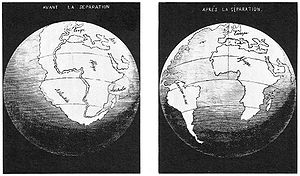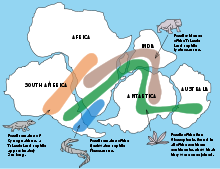- Continental drift
-
This article is about the development of the continental drift hypothesis before 1958. For the contemporary theory, see plate tectonics.
Continental drift is the movement of the Earth's continents relative to each other. The hypothesis that continents 'drift' was first put forward by Abraham Ortelius in 1596 and was fully developed by Alfred Wegener in 1912. However, it was not until the development of the theory of plate tectonics in the 1960s, that a sufficient geological explanation of that movement was found.
Contents
History
Main article: Timeline of the development of tectonophysicsEarly history
Abraham Ortelius (Ortelius 1596),[1] Theodor Christoph Lilienthal (1756),[2] Alexander von Humboldt (1801 and 1845),[2] Antonio Snider-Pellegrini (Snider-Pellegrini 1858), and others had noted earlier that the shapes of continents on opposite sides of the Atlantic Ocean (most notably, Africa and South America) seem to fit together.[3] W. J. Kious described Ortelius' thoughts in this way:[4]
Abraham Ortelius in his work Thesaurus Geographicus ... suggested that the Americas were "torn away from Europe and Africa ... by earthquakes and floods" and went on to say: "The vestiges of the rupture reveal themselves, if someone brings forward a map of the world and considers carefully the coasts of the three [continents]."Wegener and his predecessors
The hypothesis that the continents had once formed a single landmass before breaking apart and drifting to their present locations was fully formulated by Alfred Wegener in 1912.[5] Although Wegener's theory was formed independently and was more complete than those of his predecessors, Wegener later credited a number of past authors with similar ideas:[6][7] Franklin Coxworthy (between 1848 and 1890),[8] Roberto Mantovani (between 1889 and 1909), William Henry Pickering (1907)[9] and Frank Bursley Taylor (1908). John Perry had written an 1895 paper proposing that the earth's interior was fluid, and disagreeing with Lord Kelvin on the age of the earth.
For example: the similarity of southern continent geological formations had led Roberto Mantovani to conjecture in 1889 and 1909 that all the continents had once been joined into a supercontinent (now known as Pangaea); Wegener noted the similarity of Mantovani's and his own maps of the former positions of the southern continents. Through volcanic activity due to thermal expansion this continent broke and the new continents drifted away from each other because of further expansion of the rip-zones, where the oceans now lie. This led Mantovani to propose an Expanding Earth theory which has since been shown to be incorrect.[10][11][12]
Some sort of continental drift without expansion was proposed by Frank Bursley Taylor, who suggested in 1908 (published in 1910) that the continents were dragged towards the equator by increased lunar gravity during the Cretaceous, thus forming the Himalayas and Alps on the southern faces. Wegener said that of all those theories, Taylor's, although not fully developed, had the most similarities to his own.[13]
Wegener was the first to use the phrase "continental drift" (1912, 1915)[5][6] (in German "die Verschiebung der Kontinente" – translated into English in 1922) and formally publish the hypothesis that the continents had somehow "drifted" apart. Although he presented much evidence for continental drift, he was unable to provide a convincing explanation for the physical processes which might have caused this drift. His suggestion that the continents had been pulled apart by the centrifugal pseudoforce (Polflucht) of the Earth's rotation or by a small component of astronomical precession was rejected as calculations showed that the force was not sufficient.[14] The Polflucht hypothesis was also studied by Paul Sophus Epstein in 1920 and found to be implausible.
Evidence that continents 'drift'
For more details on this topic, see Plate tectonics.Evidence for continental drift is now extensive. Similar plant and animal fossils are found around different continent shores, suggesting that they were once joined. The fossils of Mesosaurus, a freshwater reptile rather like a small crocodile, found both in Brazil and South Africa, are one example; another is the discovery of fossils of the land reptile Lystrosaurus from rocks of the same age from locations in South America, Africa, and Antarctica.[15] There is also living evidence — the same animals being found on two continents. Some earthworm families (e.g.: Ocnerodrilidae, Acanthodrilidae, Octochaetidae) are found in South America and Africa, for instance.
The complementary arrangement of the facing sides of South America and Africa is obvious, but is a temporary coincidence. In millions of years, slab pull and ridge-push, and other forces of tectonophysics will further separate and rotate those two continents. It was this temporary feature which inspired Wegener to study what he defined as continental drift, although he did not live to see his hypothesis become generally accepted.
Widespread distribution of Permo-Carboniferous glacial sediments in South America, Africa, Madagascar, Arabia, India, Antarctica and Australia was one of the major pieces of evidence for the theory of continental drift. The continuity of glaciers, inferred from oriented glacial striations and deposits called tillites, suggested the existence of the supercontinent of Gondwana, which became a central element of the concept of continental drift. Striations indicated glacial flow away from the equator and toward the poles, in modern coordinates, and supported the idea that the southern continents had previously been in dramatically different locations, as well as contiguous with each other.[6]
Rejection of Wegener's theory, and subsequent vindication
While it is now accepted that the continents do move across the Earth's surface – though more in a driven mode than the aimlessness suggested by "drift" – as a theory, continental drift was not accepted for many years. One problem was that a plausible driving force was missing. And it did not help that Wegener was not a geologist.
The British geologist Arthur Holmes championed the theory of continental drift at a time when it was deeply unfashionable. He proposed that the Earth's mantle contained convection cells that dissipated radioactive heat and moved the crust at the surface. His Principles of Physical Geology, ending with a chapter on continental drift, was published in 1944.[16]
As late as 1953 – just five years before Carey[17] introduced the theory of plate tectonics – the theory of continental drift was rejected by the physicist Scheiddiger on the following grounds.[18]
- First, it had been shown that floating masses on a rotating geoid would collect at the equator, and stay there. This would explain one, but only one, mountain building episode between any pair of continents; it failed to account for earlier orogenic episodes.
- Second, masses floating freely in a fluid substratum, like icebergs in the ocean, should be in isostatic equilibrium (where the forces of gravity and buoyancy are in balance). Gravitational measurements were showing that many areas are not in isostatic equilibrium.
- Third, there was the problem of why some parts of the Earth's surface (crust) should have solidifed while other parts were still fluid. Various attempts to explain this foundered on other difficulties.
Geophysicist Jack Oliver is credited with providing seismologic evidence supporting plate tectonics which encompassed and superseded continental drift with “Seismology and the New Global Tectonics,” published in 1968, using data collected from seismologic stations, including those he set up in the South Pacific.[19]
It is now known that there are two kinds of crust, continental crust and oceanic crust. Continental crust is inherently lighter and of a different composition to oceanic crust, but both kinds reside above a much deeper fluid mantle. Oceanic crust is created at spreading centers, and this, along with subduction, drives the system of plates in a chaotic manner, resulting in continuous orogeny and areas of isostatic imbalance. The theory of plate tectonics explains all this, including the movement of the continents, better than Wegener's theory.
Bibliography
Notes:
- ^ Romm, James (February 3, 1994), "A New Forerunner for Continental Drift", Nature 367 (6462): 407–408, doi:10.1038/367407a0.
- ^ a b Schmeling, Harro (2004). "Geodynamik" (in german). Univesity of Frankfurt. http://www.geophysik.uni-frankfurt.de/~schmelin/skripte/Geodynn1-kap1-2-S1-S22-2004.pdf.
- ^ Brusatte, Stephen, Continents Adrift and Sea-Floors Spreading: The Revolution of Plate Tectonics, http://www.lib.uchicago.edu/e/crerar/crerar-prize/2003%2004%20Brusatte.pdf
- ^ Kious, W.J.; Tilling, R.I. (February 2001) [1996], "Historical perspective", This Dynamic Earth: the Story of Plate Tectonics (Online ed.), U.S. Geological Survey, ISBN 0160482208, http://pubs.usgs.gov/gip/dynamic/historical.html, retrieved 2008-01-29
- ^ a b Wegener, Alfred (6 January 1912), "Die Herausbildung der Grossformen der Erdrinde (Kontinente und Ozeane), auf geophysikalischer Grundlage", Petermanns Geographische Mitteilungen 63: 185–195, 253–256, 305–309, http://epic.awi.de/Publications/Polarforsch2005_1_3.pdf.
- ^ a b c Wegener, A. (1929/1966), The Origin of Continents and Oceans, Courier Dover Publications, ISBN 0486617084
- ^ Wegener, A. (1929), Die Entstehung der Kontinente und Ozeane (4 ed.), Braunschweig: Friedrich Vieweg & Sohn Akt. Ges.
- ^ Coxworthy, F. (1848/1924), Electrical Condition or How and Where our Earth was created, London: W. J. S. Phillips, http://www.dcd.zju.edu.cn/cgi-bin/udlcgi/ulibreader_iisc/bookReader.cgi?barcode=99999991946789&format=ptiff&curPage=1
- ^ Pickering, W.H (1907), "The Place of Origin of the Moon - The Volcani Problems", Popular Astronomy: 274–287, Bibcode 1907PA.....15..274P
- ^ Mantovani, R. (1889), "Les fractures de l’écorce terrestre et la théorie de Laplace", Bull. Soc. Sc. Et Arts Réunion: 41–53
- ^ Mantovani, R. (1909), "L’Antarctide", Je m’instruis. La science pour tous 38: 595–597
- ^ Scalera, G. (2003), "Roberto Mantovani an Italian defender of the continental drift and planetary expansion", in Scalera, G. and Jacob, K.-H., Why expanding Earth? – A book in honour of O.C. Hilgenberg, Rome: Istituto Nazionale di Geofisica e Vulcanologia, pp. 71–74, http://hdl.handle.net/2122/2017
- ^ Taylor, F.B. (1910), "Bearing of the tertiary mountain belt on the origin of the earth's plan", GSA Bulletin 21 (2): 179–226, doi:10.1130/1052-5173(2005)015[29b:WTCCA]2.0.CO;2, http://www.gsajournals.org/perlserv/?request=get-document&doi=10.1130%2F1052-5173(2005)015%5B29b%3AWTCCA%5D2.0.CO%3B2
- ^ "Plate Tectonics: The Rocky History of an Idea". http://www.ucmp.berkeley.edu/geology/techist.html. "Wegener's inability to provide an adequate explanation of the forces responsible for continental drift and the prevailing belief that the earth was solid and immovable resulted in the scientific dismissal of his theories."
- ^ "Rejoined continents [This Dynamic Earth, USGS"]. USGS. http://pubs.usgs.gov/gip/dynamic/continents.html.
- ^ Holmes, Arthur (1944). Principles of Physical Geology (1 ed.). Edinburgh: Thomas Nelson & Sons. ISBN 0174480202.
- ^ Carey, S. W. (1958), "The tectonic approach to continental drift", in Carey, S. W., Continental Drift—A symposium, Hobart: Univ. of Tasmania, pp. 177–363
- ^ Scheidegger, Adrian E. (1953), "Examination of the physics of theories of orogenesis", GSA Bulletin 64: 127–150, doi:10.1130/0016-7606(1953)64[127:EOTPOT]2.0.CO;2
- ^ Jack Oliver, Who Proved Continental Drift, Dies at 87, New York Times on-line, January 12, 2011
References:
- Le Grand, H. E. (1988), Drifting Continents and Shifting Theories, Cambridge University, ISBN 0-521-31105-5
- Ortelius, Abraham (1596), Thesaurus Geographicus (3 ed.), Antwerp: Plantin
- Snider-Pellegrini, Antonio (1858), La Création et ses mystères dévoilés, Paris: Frank and Dentu
External links
Categories:
Wikimedia Foundation. 2010.



